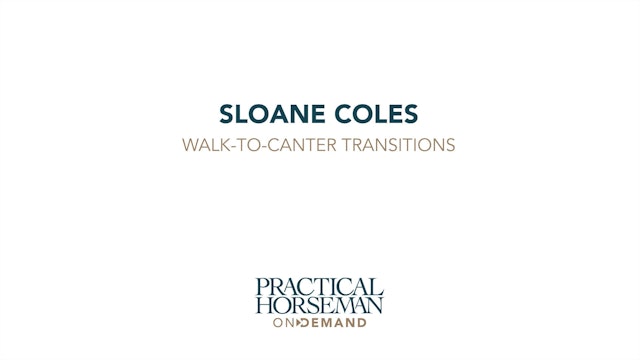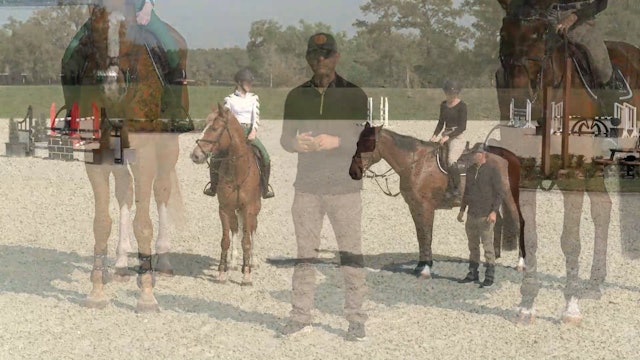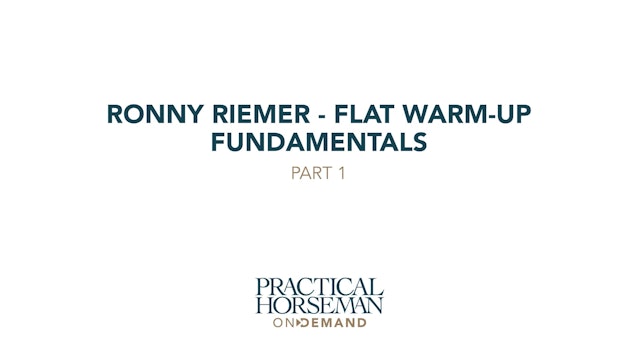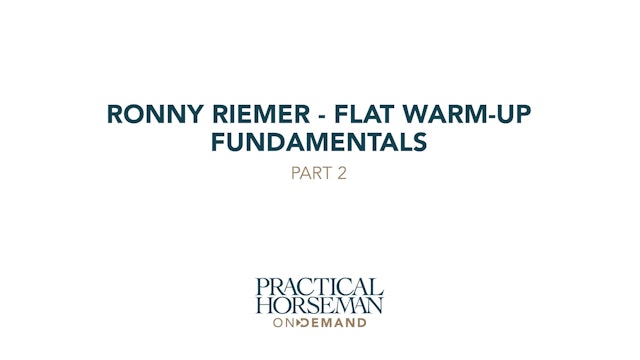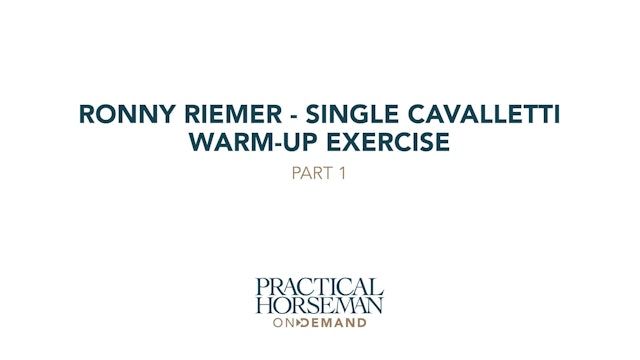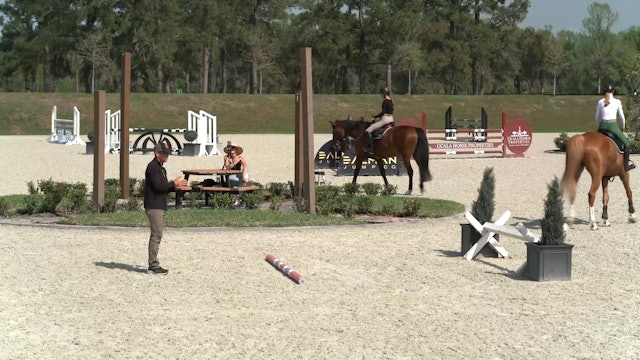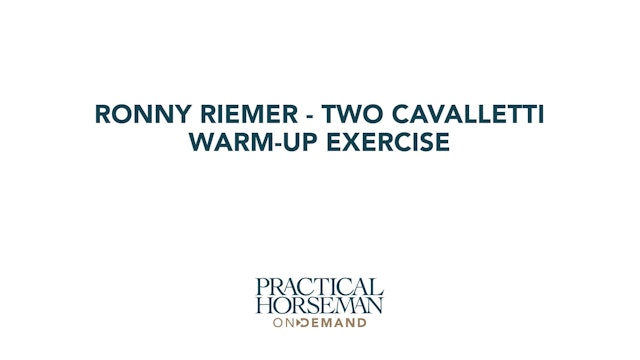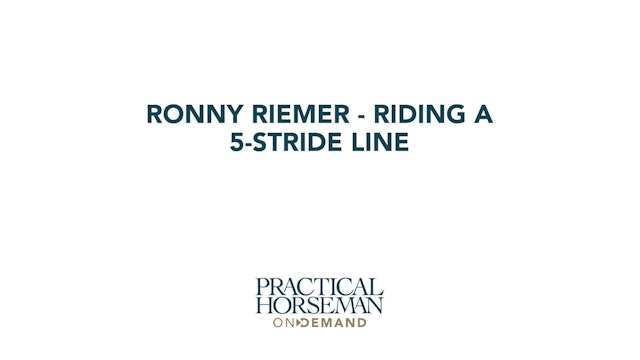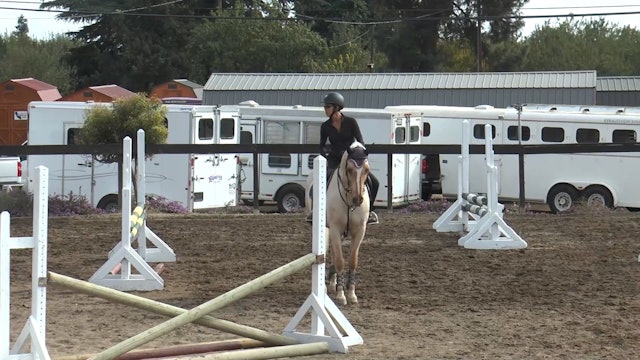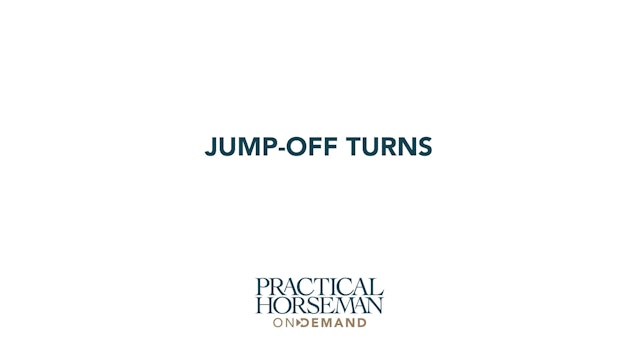Jumping
The Olympic sport of show jumping is scored objectively based solely on the horse’s athletic ability over fences as measured by time. A jumper’s only job is to clear all the fences in the course as quickly as possible without incurring any faults from knocking down a rail, refusing the jump or finishing over the allowed time. Search for your favorite coach or by training topic.
-
Creating Forward Energy and Balance for Jumpers | Kevin Babington
Kevin Babington works with a student on the flat and over fences. On the flat they work on rider position exercises and then focus on how to get a horse who is stuck in his body and behind the leg moving forward. They then work over cavalletti and some courses, applying what they worked on during...
-
12 Questions with Kevin Babington
Kevin Babington answers questions about his training philosophy, Olympic experience, the recovery process after his riding accident, what he’s learned from horses and more.
-
Balance and Straightness for Jumpers | Kevin Babington
Kevin Babington works with a student on the flat and over fences. On the flat, he focuses on balance and straightness and controlling the outside shoulder to have control of the inside leg. They then work over a cavalletti exercise, followed by a two-fence warm up on figure-eight and then some co...
-
8 Questions With Margie Engle
Olympic show jumper Margie Engle shares insight into her experiences riding tough horses, what she looks for in a horse and more.
With 250 career wins, Margie is one of the most decorated U.S. show jumpers. She earned a team silver medal at the 2006 FEI World Equestrian Games™️ and is a three-t...
-
Margie Engle’s Program - Flatwork and Gymnastics for Jumpers | PART 02
Olympic show jumper Margie Engle shares how she teaches horses to improve their form over fences. She demonstrates how to school a spooky horse on the flat and then demonstrate several gymnastic exercises, including raised cavalletti, bounces and an in-and-out with a vertical and oxer.
With 250...
-
Margie Engle’s Program - Improve Form With Gymnastics | PART 01
Olympic show jumper Margie Engle shares her basic program of teaching horses to improve their form over fences. She demonstrates flatwork and several gymnastic exercises, including raised cavalletti, bounces and an in-and-out with a vertical and oxer.
With 250 career wins, Margie is one of the m...
-
Q&A With Margie Engle
Olympic show jumper Margie Engle shares insight into her experiences riding tough horses, what she looks for in a horse and more.
With 250 career wins, Margie is one of the most decorated U.S. show jumpers. She earned a team silver medal at the 2006 FEI World Equestrian Games™️ and is a three-ti...
-
Finding a Distance | Ronny Riemer | PART 04
German show jumper Ronny Riemer shares how to put an entire course plan together using his instructions on circular approaches, finding distances, stride options on a related line and various options for correct distances on a bending line.
With over 20 years of experience, Ronny brings a wealth...
-
Finding a Distance | Ronny Riemer | PART 03
German show jumper Ronny Riemer covers various options to ride a distance on a bending line. He explains how to be on an inside track for direct approach or an outside track and what scenarios would determine your best distance.
With over 20 years of experience, Ronny brings a wealth of knowledg...
-
Finding a Distance | Ronny Riemer | PART 02
German show jumper Ronny Riemer explains how to approach a jump on straightaways and circles and how to find a good distance using the track without interfering with the horse’s stride length and pace. He also explains how different distances can work out depending on the course and your horse.
...
-
Finding a Distance | Ronny Riemer | PART 01
German show jumper Ronny Riemer shares how he walks courses and comes up with a plan, including how he measures distances, analyzes strides, determines options for bending lines and approaches combinations, for calm and confident rounds.
With over 20 years of experience, Ronny brings a wealth of...
-
Gymnastic Work | Todd Minikus
International Grand Prix show jumping star Todd Minikus works with a group of adult amateur riders. They start by warming up over a cross rail, stopping after the fence. “The most important thing an adult rider’s horse should do is stop,” he says. They move on to a gymnastic line where they focus...
-
Adult Amateur Jumpers | Todd Minikus
International Grand Prix show jumping star Todd Minikus coaches a group of adult amateur riders through several courses. He emphasizes that the riders must sit up to not get ahead of the horse and give a good release, including grabbing mane if needed. The riders also need to know when to move up...
-
Walk-to-Canter Transition | Sloane Coles
Nations Cup show jumper and successful hunter/equitation competitor Sloane Coles demonstrates the important exercise of properly executing a straight walk-canter transition. She shows all the rider aids and position of the horse that starts with walking a straight line and goes to asking the hors...
-
Jumping Fundamentals Introduction
Ronny gives a brief introduction to his series of fundamentals on the flat and over small fences. He then shows and explains the equipment used by the demonstration riders and horses.
-
Flat Warm-up Fundamentals - Part 1
Ronny explains what he likes to see in the flat warm-up, which is a loose, forward horse that flows from the hind end into the rider’s soft hand. When viewed from the side, the rider should have a shoulder, hip, heel alignment. He wants to activate the hind end first before connecting with the hand.
-
Flat Warm Up Fundamentals - Part 2
In the warm-up, they move on to the canter utilizing the same principles of getting the horse forward and relaxed. The time it takes to warm up a horse depends on the individual so it’s important to know your horse and what he needs.
-
Flat Warm-up Fundamentals - Part 3
They finish the warm-up by implementing downward transitions from canter to trot to further help the horse’s hind end come under himself and the shoulder’s come up. This also helps prepare for the over fences work when horses need to listen to the rider for collecting and extending between fences.
-
Single Cavalletti Warm-up Exercise – Part 1
After warming up on the flat, Ronny starts implementing the first jumps. To start, there is a trot pole to a small cavalletti. They move on to a ground rail to higher cavalletti. The focus is on being straight before and after the fence so that the horse is straight in front of the jump and then ...
-
Single Cavalletti Warm-up Exercise – Part 2
The next step is to do the single cavalletti at canter. The principle remains the same where the rider wants a rhythmic canter and once out of the turn, a straight approach to the fence. The horse should be straight from the shoulders to the ears. Going straight after the fence is important so th...
-
Two Cavalletti Warm-up Exercise
The last part of the warm-up consists of two cavalletti set seven strides apart. The goal is to have a steady rhythm and straight approach to the first jump, stay straight between fences, arrive straight at the second jump and then go straight afterwards for several strides before turning.
-
Riding a 5-Stride Line
Once properly warmed up, Ronny has the riders work on riding a 5-stride line. The concept is still the same to go straight before the first jump, between the two jumps and then after the second fence. A canter pole before the first jump allows the horse to have one stride before the jump and find...
-
Jumping on Square Turns | Todd Minikus
International Grand Prix show jumping star Todd Minikus has riders do an exercise of jumping a fence on a square in eight strides rather than on a circle. Doing so helps control the horse’s shoulders and keeps the rider from simply overbending the neck. The rider also must make sure the horse get...
-
Jump-Off Turns | Holly Hugo-Vidal
Holly explains how to make a tight right turn after a fence, something riders encounter in jump-offs. The ideal canter to the jump is quiet so the rider can make the turn after the fence more easily. On the approach, the rider looks to a point to the right and asks the horse to land on the right ...
















